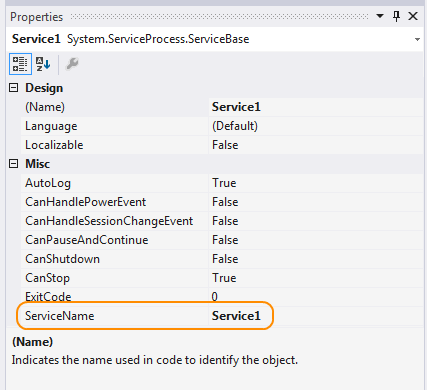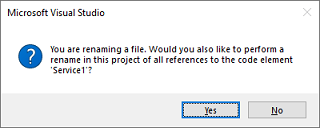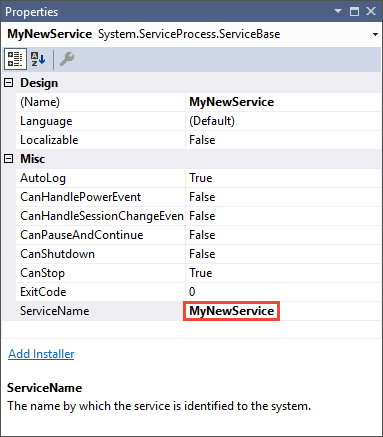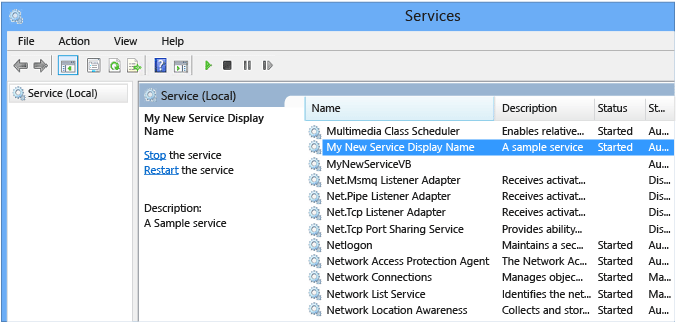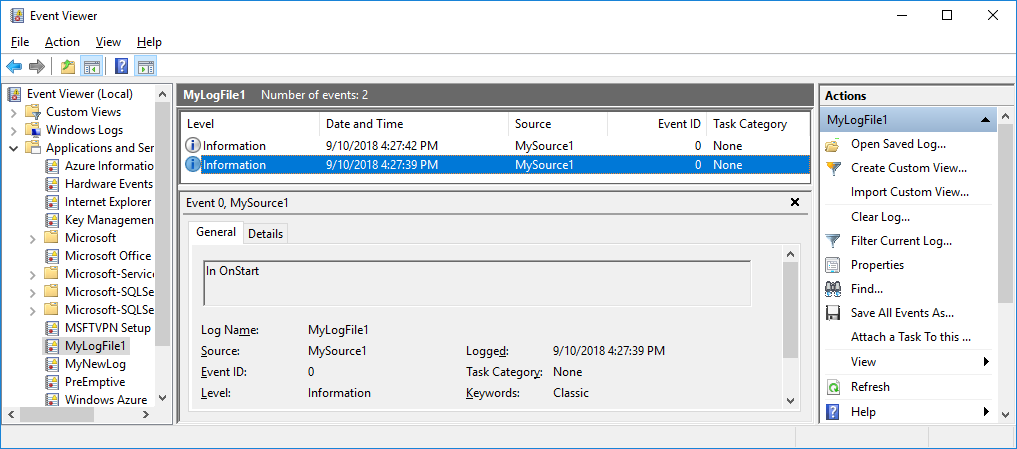- How to: Add Installers to Your Service Application
- To add installers to your service application
- How to: Create Windows Services
- To create a Windows Service application
- Tutorial: Create a Windows service app
- Create a service
- Rename the service
- Add features to the service
- Add custom event log functionality
- Define what occurs when the service starts
- Polling
- Define what occurs when the service is stopped
- Define other actions for the service
- Set service status
- Implement service pending status
- Add installers to the service
- (Optional) Set startup parameters
- To add startup parameters
- Build the service
- Install the service
- Start and run the service
- Verify the event log output of your service
- Clean up resources
- Next steps
How to: Add Installers to Your Service Application
Visual Studio ships installation components that can install resources associated with your service applications. Installation components register an individual service on the system to which it is being installed and let the Services Control Manager know that the service exists. When you work with a service application, you can select a link in the Properties window to automatically add the appropriate installers to your project.
Property values for your service are copied from the service class to the installer class. If you update the property values on the service class, they are not automatically updated in the installer.
When you add an installer to your project, a new class (which, by default, is named ProjectInstaller ) is created in the project, and instances of the appropriate installation components are created within it. This class acts as a central point for all of the installation components your project needs. For example, if you add a second service to your application and click the Add Installer link, a second installer class is not created; instead, the necessary additional installation component for the second service is added to the existing class.
You do not need to do any special coding within the installers to make your services install correctly. However, you may occasionally need to modify the contents of the installers if you need to add special functionality to the installation process.
The dialog boxes and menu commands you see might differ from those described in Help depending on your active settings or edition. To change your settings, choose Import and Export Settings on the Tools menu. For more information, see Personalize the Visual Studio IDE.
To add installers to your service application
In Solution Explorer, access Design view for the service for which you want to add an installation component.
Click the background of the designer to select the service itself, rather than any of its contents.
With the designer in focus, right-click, and then click Add Installer.
A new class, ProjectInstaller , and two installation components, ServiceProcessInstaller and ServiceInstaller, are added to your project, and property values for the service are copied to the components.
Click the ServiceInstaller component and verify that the value of the ServiceName property is set to the same value as the ServiceName property on the service itself.
To determine how your service will be started, click the ServiceInstaller component and set the StartType property to the appropriate value.
| Value | Result |
|---|---|
| Manual | The service must be manually started after installation. For more information, see How to: Start Services. |
| Automatic | The service will start by itself whenever the computer reboots. |
| Disabled | The service cannot be started. |
To determine the security context in which your service will run, click the ServiceProcessInstaller component and set the appropriate property values. For more information, see How to: Specify the Security Context for Services.
Override any methods for which you need to perform custom processing.
Perform steps 1 through 7 for each additional service in your project.
For each additional service in your project, you must add an additional ServiceInstaller component to the project’s ProjectInstaller class. The ServiceProcessInstaller component added in step three works with all of the individual service installers in the project.
How to: Create Windows Services
When you create a service, you can use a Visual Studio project template called Windows Service. This template automatically does much of the work for you by referencing the appropriate classes and namespaces, setting up the inheritance from the base class for services, and overriding several of the methods you’re likely to want to override.
The Windows Services project template is not available in the Express edition of Visual Studio.
At a minimum, to create a functional service you must:
Set the ServiceName property.
Create the necessary installers for your service application.
Override and specify code for the OnStart and OnStop methods to customize the ways in which your service behaves.
To create a Windows Service application
Create a Windows Service project.
For instructions on writing a service without using the template, see How to: Write Services Programmatically.
In the Properties window, set the ServiceName property for your service.
The value of the ServiceName property must always match the name recorded in the installer classes. If you change this property, you must update the ServiceName property of installer classes as well.
Set any of the following properties to determine how your service will function.
| Property | Setting |
|---|---|
| CanStop | True to indicate that the service will accept requests to stop running; false to prevent the service from being stopped. |
| CanShutdown | True to indicate that the service wants to receive notification when the computer on which it lives shuts down, enabling it to call the OnShutdown procedure. |
| CanPauseAndContinue | True to indicate that the service will accept requests to pause or to resume running; false to prevent the service from being paused and resumed. |
| CanHandlePowerEvent | True to indicate that the service can handle notification of changes to the computer’s power status; false to prevent the service from being notified of these changes. |
| AutoLog | True to write informational entries to the Application event log when your service performs an action; false to disable this functionality. For more information, see How to: Log Information About Services. Note: By default, AutoLog is set to true . |
When CanStop or CanPauseAndContinue are set to false , the Service Control Manager will disable the corresponding menu options to stop, pause, or continue the service.
Access the Code Editor and fill in the processing you want for the OnStart and OnStop procedures.
Override any other methods for which you want to define functionality.
Add the necessary installers for your service application. For more information, see How to: Add Installers to Your Service Application.
Build your project by selecting Build Solution from the Build menu.
Do not press F5 to run your project — you cannot run a service project in this way.
Install the service. For more information, see How to: Install and Uninstall Services.
Tutorial: Create a Windows service app
This article demonstrates how to create a Windows service app in Visual Studio that writes messages to an event log.
Create a service
To begin, create the project and set the values that are required for the service to function correctly.
From the Visual Studio File menu, select New > Project (or press Ctrl+Shift+N) to open the New Project window.
Navigate to and select the Windows Service (.NET Framework) project template. To find it, expand Installed and Visual C# or Visual Basic, then select Windows Desktop. Or, enter Windows Service in the search box on the upper right and press Enter.
If you don’t see the Windows Service template, you may need to install the .NET desktop development workload:
In the New Project dialog, select Open Visual Studio Installer on the lower left. Select the .NET desktop development workload, and then select Modify.
For Name, enter MyNewService, and then select OK.
The Design tab appears (Service1.cs [Design] or Service1.vb [Design]).
The project template includes a component class named Service1 that inherits from System.ServiceProcess.ServiceBase. It includes much of the basic service code, such as the code to start the service.
Rename the service
Rename the service from Service1 to MyNewService.
In Solution Explorer, select Service1.cs, or Service1.vb, and choose Rename from the shortcut menu. Rename the file to MyNewService.cs, or MyNewService.vb, and then press Enter
A pop-up window appears asking whether you would like to rename all references to the code element Service1.
In the pop-up window, select Yes.
In the Design tab, select Properties from the shortcut menu. From the Properties window, change the ServiceName value to MyNewService.
Select Save All from the File menu.
Add features to the service
In this section, you add a custom event log to the Windows service. The EventLog component is an example of the type of component you can add to a Windows service.
Add custom event log functionality
In Solution Explorer, from the shortcut menu for MyNewService.cs, or MyNewService.vb, choose View Designer.
In Toolbox, expand Components, and then drag the EventLog component to the Service1.cs [Design], or Service1.vb [Design] tab.
In Solution Explorer, from the shortcut menu for MyNewService.cs, or MyNewService.vb, choose View Code.
Define a custom event log. For C#, edit the existing MyNewService() constructor; for Visual Basic, add the New() constructor:
Add a using statement to MyNewService.cs (if it doesn’t already exist), or an Imports statement MyNewService.vb, for the System.Diagnostics namespace:
Select Save All from the File menu.
Define what occurs when the service starts
In the code editor for MyNewService.cs or MyNewService.vb, locate the OnStart method; Visual Studio automatically created an empty method definition when you created the project. Add code that writes an entry to the event log when the service starts:
Polling
Because a service application is designed to be long-running, it usually polls or monitors the system, which you set up in the OnStart method. The OnStart method must return to the operating system after the service’s operation has begun so that the system isn’t blocked.
To set up a simple polling mechanism, use the System.Timers.Timer component. The timer raises an Elapsed event at regular intervals, at which time your service can do its monitoring. You use the Timer component as follows:
- Set the properties of the Timer component in the MyNewService.OnStart method.
- Start the timer by calling the Start method.
Set up the polling mechanism.
Add the following code in the MyNewService.OnStart event to set up the polling mechanism:
Add a using statement to MyNewService.cs, or an Imports statement to MyNewService.vb, for the System.Timers namespace:
In the MyNewService class, add the OnTimer method to handle the Timer.Elapsed event:
In the MyNewService class, add a member variable. It contains the identifier of the next event to write into the event log:
Instead of running all your work on the main thread, you can run tasks by using background worker threads. For more information, see System.ComponentModel.BackgroundWorker.
Define what occurs when the service is stopped
Insert a line of code in the OnStop method that adds an entry to the event log when the service is stopped:
Define other actions for the service
You can override the OnPause, OnContinue, and OnShutdown methods to define additional processing for your component.
The following code shows how you to override the OnContinue method in the MyNewService class:
Set service status
Services report their status to the Service Control Manager so that a user can tell whether a service is functioning correctly. By default, a service that inherits from ServiceBase reports a limited set of status settings, which include SERVICE_STOPPED, SERVICE_PAUSED, and SERVICE_RUNNING. If a service takes a while to start up, it’s useful to report a SERVICE_START_PENDING status.
You can implement the SERVICE_START_PENDING and SERVICE_STOP_PENDING status settings by adding code that calls the Windows SetServiceStatus function.
Implement service pending status
Add a using statement to MyNewService.cs, or an Imports statement to MyNewService.vb, for the System.Runtime.InteropServices namespace:
Add the following code to MyNewService.cs, or MyNewService.vb, to declare the ServiceState values and to add a structure for the status, which you’ll use in a platform invoke call:
The Service Control Manager uses the dwWaitHint and dwCheckpoint members of the SERVICE_STATUS structure to determine how much time to wait for a Windows service to start or shut down. If your OnStart and OnStop methods run long, your service can request more time by calling SetServiceStatus again with an incremented dwCheckPoint value.
In the MyNewService class, declare the SetServiceStatus function by using platform invoke:
To implement the SERVICE_START_PENDING status, add the following code to the beginning of the OnStart method:
Add code to the end of the OnStart method to set the status to SERVICE_RUNNING:
(Optional) If OnStop is a long-running method, repeat this procedure in the OnStop method. Implement the SERVICE_STOP_PENDING status and return the SERVICE_STOPPED status before the OnStop method exits.
Add installers to the service
Before you run a Windows service, you need to install it, which registers it with the Service Control Manager. Add installers to your project to handle the registration details.
In Solution Explorer, from the shortcut menu for MyNewService.cs, or MyNewService.vb, choose View Designer.
In the Design view, select the background area, then choose Add Installer from the shortcut menu.
By default, Visual Studio adds a component class named ProjectInstaller , which contains two installers, to your project. These installers are for your service and for the service’s associated process.
In the Design view for ProjectInstaller, select serviceInstaller1 for a Visual C# project, or ServiceInstaller1 for a Visual Basic project, then choose Properties from the shortcut menu.
In the Properties window, verify the ServiceName property is set to MyNewService.
Add text to the Description property, such as A sample service.
This text appears in the Description column of the Services window and describes the service to the user.
Add text to the DisplayName property. For example, MyNewService Display Name.
This text appears in the Display Name column of the Services window. This name can be different from the ServiceName property, which is the name the system uses (for example, the name you use for the net start command to start your service).
Set the StartType property to Automatic from the drop-down list.
When you’re finished, the Properties windows should look like the following figure:
In the Design view for ProjectInstaller, choose serviceProcessInstaller1 for a Visual C# project, or ServiceProcessInstaller1 for a Visual Basic project, then choose Properties from the shortcut menu. Set the Account property to LocalSystem from the drop-down list.
This setting installs the service and runs it by using the local system account.
The LocalSystem account has broad permissions, including the ability to write to the event log. Use this account with caution, because it might increase your risk of attacks from malicious software. For other tasks, consider using the LocalService account, which acts as a non-privileged user on the local computer and presents anonymous credentials to any remote server. This example fails if you try to use the LocalService account, because it needs permission to write to the event log.
(Optional) Set startup parameters
Before you decide to add startup parameters, consider whether it’s the best way to pass information to your service. Although they’re easy to use and parse, and a user can easily override them, they might be harder for a user to discover and use without documentation. Generally, if your service requires more than just a few startup parameters, you should use the registry or a configuration file instead.
A Windows service can accept command-line arguments, or startup parameters. When you add code to process startup parameters, a user can start your service with their own custom startup parameters in the service properties window. However, these startup parameters aren’t persisted the next time the service starts. To set startup parameters permanently, set them in the registry.
Each Windows service has a registry entry under the HKEY_LOCAL_MACHINE\SYSTEM\CurrentControlSet\Services subkey. Under each service’s subkey, use the Parameters subkey to store information that your service can access. You can use application configuration files for a Windows service the same way you do for other types of programs. For sample code, see ConfigurationManager.AppSettings.
To add startup parameters
Select Program.cs, or MyNewService.Designer.vb, then choose View Code from the shortcut menu. In the Main method, change the code to add an input parameter and pass it to the service constructor:
In MyNewService.cs, or MyNewService.vb, change the MyNewService constructor to process the input parameter as follows:
This code sets the event source and log name according to the startup parameters that the user supplies. If no arguments are supplied, it uses default values.
To specify the command-line arguments, add the following code to the ProjectInstaller class in ProjectInstaller.cs, or ProjectInstaller.vb:
Typically, this value contains the full path to the executable for the Windows service. For the service to start up correctly, the user must supply quotation marks for the path and each individual parameter. A user can change the parameters in the ImagePath registry entry to change the startup parameters for the Windows service. However, a better way is to change the value programmatically and expose the functionality in a user-friendly way, such as by using a management or configuration utility.
Build the service
In Solution Explorer, choose Properties from the shortcut menu for the MyNewService project.
The property pages for your project appear.
On the Application tab, in the Startup object list, choose MyNewService.Program, or Sub Main for Visual Basic projects.
To build the project, in Solution Explorer, choose Build from the shortcut menu for your project (or press Ctrl+Shift+B).
Install the service
Now that you’ve built the Windows service, you can install it. To install a Windows service, you must have administrator credentials on the computer where it’s installed.
In Developer Command Prompt for Visual Studio, navigate to the folder that contains your project’s output (by default, the \bin\Debug subdirectory of your project).
Enter the following command:
If the service installs successfully, the command reports success.
If the system can’t find installutil.exe, make sure that it exists on your computer. This tool is installed with the .NET Framework to the folder %windir%\Microsoft.NET\Framework[64]\ . For example, the default path for the 64-bit version is %windir%\Microsoft.NET\Framework64\v4.0.30319\InstallUtil.exe.
If the installutil.exe process fails, check the install log to find out why. By default, the log is in the same folder as the service executable. The installation can fail if:
- The RunInstallerAttribute class isn’t present on the ProjectInstaller class.
- The attribute isn’t set to true .
- The ProjectInstaller class isn’t defined as public .
Start and run the service
In Windows, open the Services desktop app. Press Windows+R to open the Run box, enter services.msc, and then press Enter or select OK.
You should see your service listed in Services, displayed alphabetically by the display name that you set for it.
To start the service, choose Start from the service’s shortcut menu.
To stop the service, choose Stop from the service’s shortcut menu.
(Optional) From the command line, use the commands net start and net stop to start and stop your service.
Verify the event log output of your service
In Windows, open the Event Viewer desktop app. Enter Event Viewer in the Windows search bar, and then select Event Viewer from the search results.
In Visual Studio, you can access event logs by opening Server Explorer from the View menu (or press Ctrl+Alt+S) and expanding the Event Logs node for the local computer.
In Event Viewer, expand Applications and Services Logs.
Locate the listing for MyNewLog (or MyLogFile1 if you followed the procedure to add command-line arguments) and expand it. You should see the entries for the two actions (start and stop) that your service performed.
Clean up resources
If you no longer need the Windows service app, you can remove it.
Open Developer Command Prompt for Visual Studio with administrative credentials.
In the Developer Command Prompt for Visual Studio window, navigate to the folder that contains your project’s output.
Enter the following command:
If the service uninstalls successfully, the command reports that your service was successfully removed. For more information, see How to: Install and uninstall services.
Next steps
Now that you’ve created the service, you can:
Create a standalone setup program for others to use to install your Windows service. Use the WiX Toolset to create an installer for a Windows service. For other ideas, see Create an installer package.
Explore the ServiceController component, which enables you to send commands to the service you’ve installed.
Instead of creating the event log when the application runs, use an installer to create an event log when you install the application. The event log is deleted by the installer when you uninstall the application. For more information, see EventLogInstaller.
